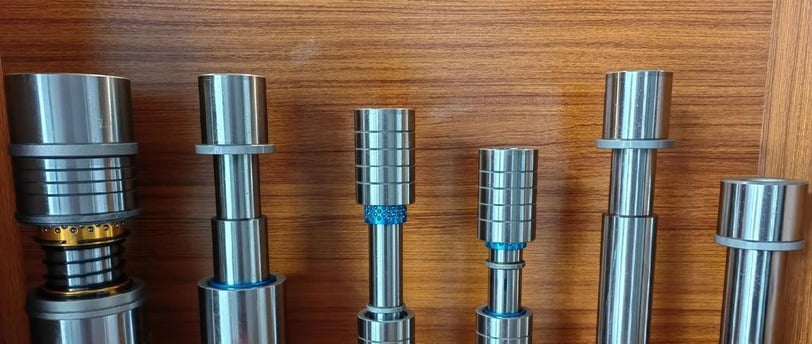How to Apply High-Performance Alloys in Stamping Molds
2/26/2025


Understanding High-Performance Alloys
High-performance alloys are advanced materials engineered to exhibit superior properties that surpass those found in standard materials commonly used in manufacturing applications such as stamping molds. These specialized alloys are formulated through the precise combination of various metals, including nickel, cobalt, titanium, and molybdenum, among others. Their unique composition grants them enhanced mechanical properties, making them particularly suitable for the most demanding environments.
One of the defining characteristics of high-performance alloys is their increased strength. Unlike standard steel or aluminum materials, these alloys maintain their structural integrity even at elevated temperatures or under significant stress, which is a common scenario in stamping processes. This durability not only prolongs the life of the stamping molds but also ensures the quality of the produced components remains high over extended production runs.
Corrosion resistance is another critical property of high-performance alloys that distinguishes them from conventional materials. In many industrial environments, especially those involving exposure to moisture, chemicals, or extreme temperatures, the risk of corrosion can lead to substantial operational problems and downtime. High-performance alloys are engineered to resist such degradation, thereby enhancing their reliability and reducing maintenance requirements.
Thermal stability is an essential attribute as well. The ability of high-performance alloys to withstand rapid temperature fluctuations without losing their properties is vital in stamping applications, where molds may experience sudden changes in temperature. This stability ensures consistent performance and reduces the likelihood of mold failure.
In selecting the right high-performance alloy for specific stamping applications, factors such as the desired strength, corrosion resistance, and thermal stability must be considered. Assessing these properties in relation to the specific demands of the application can significantly improve production efficiency and product quality.
Advantages of Using High-Performance Alloys in Stamping Molds
High-performance alloys are increasingly being adopted in the manufacturing of stamping molds due to their numerous advantages. One of the most significant benefits is enhanced mold longevity. Unlike traditional materials, high-performance alloys exhibit exceptional resistance to deformation and fatigue, allowing them to withstand the rigorous demands of the stamping process. This extended lifespan not only reduces the frequency of mold replacements but also diminishes maintenance requirements, contributing to overall operational efficiency.
In addition to mold longevity, high-performance alloys are renowned for reducing wear and tear during operations. The superior hardness and wear resistance of these materials ensure that they maintain their structural integrity even under high-stress conditions. This inherently leads to improved dimensional accuracy, which is critical in applications requiring precision engineering. High-performance alloys can maintain tight tolerances throughout the stamping process, reducing the likelihood of defects and ensuring that the final products meet stringent quality standards.
Heat resistance is another pivotal advantage of using high-performance alloys in stamping molds. These alloys can effectively withstand the elevated temperatures typical in stamping operations without losing their mechanical properties. This heat resistance is essential in preventing warping and distortion, which can adversely affect the final product. As a result, manufacturers can achieve consistent quality and reliability in their output.
The integration of high-performance alloys not only enhances productivity by reducing downtime associated with mold maintenance but also lowers operational costs over time. For example, a case study involving a major automotive component manufacturer demonstrated that the transition to high-performance alloys resulted in a staggering 30% reduction in production costs over a five-year period, alongside improved cycle times and a significant decrease in scrap rates. Such compelling data reflects the effectiveness and economic viability of utilizing high-performance alloys in various stamping applications.
Best Practices for Implementing High-Performance Alloys in Stamping Molds
The successful application of high-performance alloys in the design and manufacturing of stamping molds hinges on several best practices. Firstly, careful selection of the appropriate alloy is crucial, as various alloys possess distinct properties that cater to specific molding requirements. Factors such as the intended application, corrosion resistance, wear characteristics, and thermal stability must be evaluated in order to choose an alloy that meets the performance demands of the stamping process.
Once the appropriate alloy has been selected, attention must be directed towards processing techniques. High-performance alloys often require specialized machining and fabrication methods to maintain their integrity and performance standards. Techniques such as precision machining and advanced welding practices can enhance the structural characteristics and longevity of the molds. Employing accurate temperature control and swift cooling processes during fabrication is also advised, as these aspects significantly affect the physical properties of the alloy.
In addition, applying various treatments or coatings can further enhance the performance of high-performance alloys used in stamping molds. Surface treatments such as nitriding or hardcoating can improve hardness, reduce friction, and increase the durability of the mold surfaces. Additionally, utilizing corrosion inhibitors or specialized lubricants during the stamping process can contribute to extending the life of the molds.
Maintaining molds made from high-performance alloys is essential to ensure their durability and efficiency. Regular inspection, cleaning, and preventive maintenance should be scheduled to identify and address potential wear or damage early on. Employing practices such as proper storage, environment control to prevent corrosion, and using the correct operating parameters during the stamping process can greatly enhance the overall lifespan of the molds. By combining these best practices, manufacturers can effectively leverage the advantages of high-performance alloys in stamping molds, leading to improved production outcomes and reduced operational costs.
Future Trends and Innovations in High-Performance Alloys
The stamping mold industry is poised for significant transformations driven by advancements in high-performance alloys and their applications. Research initiatives are currently focusing on enhancing the mechanical properties and corrosion resistance of these materials. Innovations in alloy compositions, such as multi-component or hybrid alloys, are being explored to forge new pathways in mold design. These new formulations aim to optimize performance while maintaining cost-effectiveness, enabling manufacturers to push the limits of traditional stamped products.
Another noteworthy trend is the development of processing techniques that enhance the fabricability of high-performance alloys. Techniques such as additive manufacturing and advanced machining are expanding the capability to create complex geometries, which were previously difficult to achieve with conventional methods. These technologies allow for a more efficient use of materials, reducing waste and improving overall production efficiency. The integration of high-performance alloys in such advanced manufacturing processes supports the industry's shift towards smarter, more resource-efficient practices.
Sustainability is also emerging as a crucial factor in the selection and application of high-performance alloys. The metalworking sector is increasingly adopting eco-friendly practices, and high-performance alloys show promise in this realm. Their durability often leads to longer product lifespans, therefore minimizing waste. Additionally, advancements in recycling technologies for these alloys can significantly lessen the environmental impact associated with raw material extraction and processing.
As we look to the future, the role of high-performance alloys in the stamping mold industry seems exceptionally promising. Ongoing research into new materials coupled with processing innovations could redefine industry standards, ultimately leading to a more sustainable and efficient manufacturing landscape. With the prospects of improved properties and enhanced performance, these alloys are set to play a pivotal role in shaping the future of manufacturing technologies, including applications in 3D printing.
